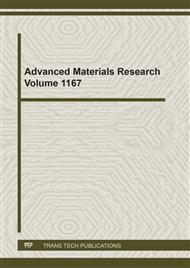[1]
W. Jehle, T. Staneff, B. Wagner, Separation of glycol and water from coolant liquids by evaporation, reverse osmosis and pervaporation, J. Memb. Sci. 102 (1995) 9-19.
DOI: 10.1016/0376-7388(94)00202-a
Google Scholar
[2]
F. Zunino, K. Scrivener, Increasing the kaolinite content of raw clays using particle classification techniques for use as supplementary cementitious materials. Constr. Build. Mater. 244 (2020) 118335.
DOI: 10.1016/j.conbuildmat.2020.118335
Google Scholar
[3]
P. Prziwara, Comparative study of the grinding aid effects for dry fine grinding of different materials, Miner. Eng. 144 (2019) 106030.
DOI: 10.1016/j.mineng.2019.106030
Google Scholar
[4]
H. Jung, Y. Lee, W. Yoon, Effect of moisture content on the grinding process and powder properties in food: a review, Processes 6 (2018) 69.
DOI: 10.3390/pr6060069
Google Scholar
[5]
W. Li, The mechanochemical process and properties of Portland cement with the addition of new alkanolamines, Powder Technol. 286 (2015) 750–756.
DOI: 10.1016/j.powtec.2015.09.024
Google Scholar
[6]
N.A. Toprak, The influences and selection of grinding chemicals in cement grinding circuits, Constr. Build. Mater. 68 (2014) 199–205.
DOI: 10.1016/j.conbuildmat.2014.06.079
Google Scholar
[7]
P. Prziwara, S. Breitung-Faes, A. Kwade, Impact of the powder flow behavior on continuous fine grinding in dry operated stirred media mills, Miner. Eng. 128 (2018) 215–223.
DOI: 10.1016/j.mineng.2018.08.032
Google Scholar
[8]
P. Prziwara, Impact of grinding aids and process parameters on dry stirred media milling, Powder Technol. 335 (2018) 114-123.
DOI: 10.1016/j.powtec.2018.05.021
Google Scholar
[9]
H.S. Gökcen, S. Cayırlı, Y. Ucbas, K. Kayaci, The effect of grinding aids on dry micro fine grinding of feldspar, Int. J. Miner. Process. 136 (2015) 42–44.
DOI: 10.1016/j.minpro.2014.10.001
Google Scholar
[10]
C.F. Burmeister, Experimental and computational investigation of knoevenagel condensation in planetary ball mills, Chem. Eng. Technol. 37 (2014) 857–864.
DOI: 10.1002/ceat.201300738
Google Scholar
[11]
P. Prziwara, Grinding aids for dry fine grinding processes – Part I: Mechanism of action and lab-scale grinding, Powder Technol. 375 (2020) 146-160.
DOI: 10.1016/j.powtec.2020.07.038
Google Scholar
[12]
O.Y. Toraman, Effect of chemical additive on stirred bead milling of calcite powder, Powder Technol. 221 (2012) 189–191.
DOI: 10.1016/j.powtec.2011.12.067
Google Scholar
[13]
Z. Sun, A grindability model for grinding aids and their impact on cement properties, Adv. Cem. Res. 28 (2016) 475–484.
Google Scholar
[14]
J. Zhao, D. Wang, P. Yan, S. Zhao, D. Zhang, Particle characteristics and hydration activity of ground granulated blast furnace slag powder containing industrial crude glycerol-based grinding aids, Constr. Build. Mater. 104 (2016) 134–141.
DOI: 10.1016/j.conbuildmat.2015.12.043
Google Scholar
[15]
N. Alper Toprak, Okay Altun, Namık Aydogan, Hakan Benzer: The influences and selection of grinding chemicals in cement grinding circuits, Constr. Build. Mater. 68 (2014) 199–205.
DOI: 10.1016/j.conbuildmat.2014.06.079
Google Scholar
[16]
S. Ma, W. Li, S. Zhang, Y. Hu, X. Shen, Study on the hydration and microstructure of Portland cement containing diethanol-isopropanolamine, Cem. Concr. Res. 67 (2015) 122-130.
DOI: 10.1016/j.cemconres.2014.09.002
Google Scholar
[17]
P. Prziwara, L.D. Hamilton, S. Breitung-Faes, A. Kwade, Evaluation of the capturing of dry fine particles between grinding media by drop-weight tests, Powder Technol. 363 (2020) 326–336.
DOI: 10.1016/j.powtec.2020.01.012
Google Scholar
[18]
Y. Chen, X. Lian, Z. Li, S. Zheng, Z. Wang, Effects of rotation speed and media density on particle size distribution and structure of ground calcium carbonate in a planetary ball mill, Adv. Powder Technol. 26 (2015) 505–510.
DOI: 10.1016/j.apt.2014.12.007
Google Scholar
[19]
B. Oksuzoglu, M. Ucurum, An experimental study on the ultra-fine grinding of gypsum ore in a dry ball mill, Powder Technol. 291 (2016) 186–192.
DOI: 10.1016/j.powtec.2015.12.027
Google Scholar
[20]
A. Pérez, A. Favier, K. Scrivener, F. Martirena, Influence Grinding Procedure, Limestone Content and PSD of Components on Properties of Clinker-Calcined Clay-Limestone Cements Produced by Intergrinding, Calcined Clays Sustain. Concr., Springer (2018) 358–365.
DOI: 10.1007/978-94-024-1207-9_58
Google Scholar
[21]
S. Zhenping, Influence of glycerin grinding aid on the compatibility between cement and polycarboxylate superplasticizer and its mechanism. Constr. Build. Mater. 233 (2020) 117104.
DOI: 10.1016/j.conbuildmat.2019.117104
Google Scholar
[22]
Y.L. Yaphary, Z. Yu, R.H.W. Lam, D. Lau, Effect of triethanolamine on cement hydration toward initial setting time, Constr. Build. Mater. 141 (2017) 94–103.
DOI: 10.1016/j.conbuildmat.2017.02.072
Google Scholar


